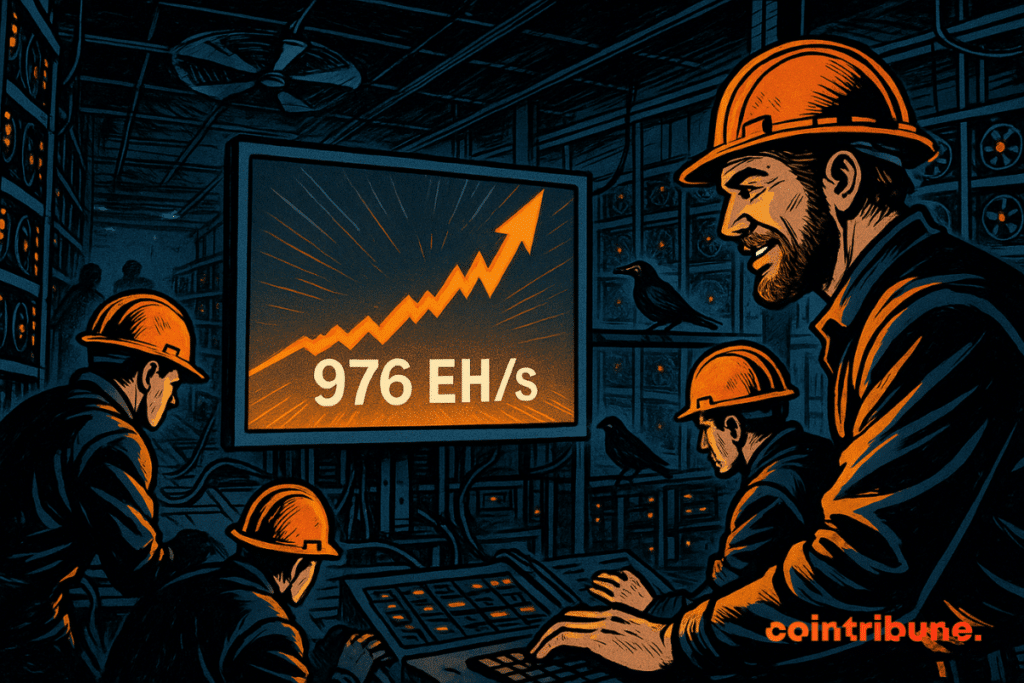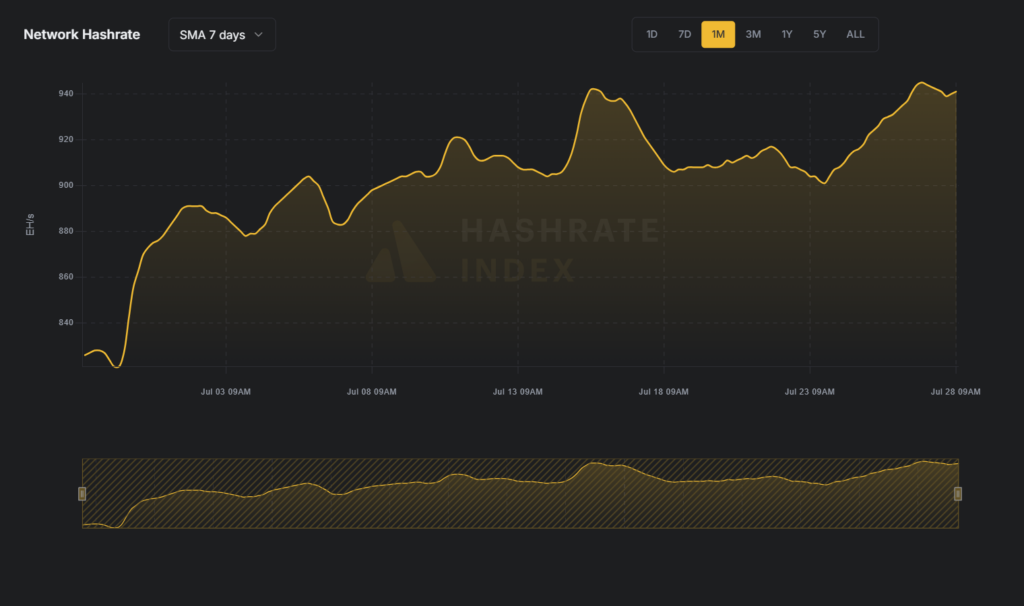Bitcoin Hashrate Nears Record High as Stable Mining Returns Boost Network Security
Bitcoin’s computational power has recorded an uptick in the past day, surging close to previous levels—a trend that is viewed as a net positive for miners. As the higher hash rate boosts the blockchain’s security and robustness, miners benefit from increased profits.

In Brief
- Bitcoin’s hashrate hit 942.96 EH/s, just shy of its all-time high, driven by stable mining profits and increased activity.
- Hashprice hovered between $58 and $60 PH/s recently, helping sustain miner interest and network computing power.
- Faster block times suggest a likely mining difficulty increase on August 8 to stabilize block production pace.
- Foundry leads all mining pools with 299.58 EH/s, followed by F2Pool and AntPool, showing growing industry competition.
Mining Momentum Builds as Hashrate Climbs and Rewards Stabilize
On July 27, Bitcoin’s hashrate breezed past 942.96 exahashes per second (EH/s), trailing its record high by just over 3 EH/s. For context, a high hash rate connotes that a lot of computing power is being used to mine Bitcoin, which usually happens when mining is profitable.
Over the past month, mining earnings have been more stable, thus attracting more miners and pushing the hashrate close to record levels.

Between June 27 and July 10, Bitcoin’s hashprice surged from $54 per petahash per second (PH/s) to a monthly high of $64 PH/s. However, this uptick was short-lived, as a drop-off followed, alongside fluctuations between $58 and $62 PH/s.
For clarity, hashprice is a system that calculates the daily revenue Bitcoin miners can earn per hash rate unit. It is generally measured in dollars per terahash per second per day ($/TH/s/day).
These are factors that could influence the hashprice:
- Bitcoin price: Miners can earn more money when the Bitcoin price appreciates.
- Mining difficulty: When difficulty increases, it becomes harder to earn Bitcoin with the same equipment.
- Block rewards and fees: If miners earn more from rewards and transaction fees, they make more money.
- Network hashrate: More miners on the network means more competition, which can lower how much each miner earns.
Over the past few weeks, the hashprice has been relatively flat, mainly within $58 PH/s and $60 PH/s. At the time of writing, the Bitcoin hashprice is pegged at $59.01, and the average block stands at 9 minutes and 44 seconds.
This means that blocks are being mined faster than the standard 10-minute target. Supposing this strong momentum continues, the network will likely increase the mining difficulty on August 8 to steady the pace.
Foundry Leads Global Bitcoin Mining Pools with Highest Hashrate
In terms of hashrate production, the mining firm Foundry tops the leaderboard, producing the most computing power—299.58 exahashes per second (EH/s). Hashrate production refers to the computing power a Bitcoin miner, or the entire network, generates to solve blocks and earn rewards.
Here are the other mining pools that make up the top ten:
- F2Pool comes second, producing 172.10 EH/s of power.
- AntPool follows closely with 159.35 EH/s in hashrate.
- ViaBTC runs at 133.85 EH/s, holding fourth place.
- Luxor mines at 57.37 EH/s, tied in fifth spot.
- SpiderPool also posts 57.37 EH/s, matching Luxor exactly.
- SECPOOL generates 31.87 EH/s, taking seventh position overall.
- MARA Pool works at 19.12 EH/s, ranks eighth.
- SBI Crypto contributes 12.75 EH/s to the network.
- BTC.com rounds out the list with 6.37 EH/s.
Similar to the hashprice movement, Bitcoin has traded steadily since reaching a fresh all-time high of $123.000 on July 14. As of press time, the firstborn asset is exchanging hands at $118,657 following a modest intraday climb.
Maximize your Cointribune experience with our "Read to Earn" program! For every article you read, earn points and access exclusive rewards. Sign up now and start earning benefits.

James Godstime is a crypto journalist and market analyst with over three years of experience in crypto, Web3, and finance. He simplifies complex and technical ideas to engage readers. Outside of work, he enjoys football and tennis, which he follows passionately.
The views, thoughts, and opinions expressed in this article belong solely to the author, and should not be taken as investment advice. Do your own research before taking any investment decisions.